Our story
This Chapter
Roots of authority
Religious belief
Status
The longest pedigree
Oral transmission
Religious belief systems
DNA
Motivations
Types of charts
Bibliography
Temper of the times
Footnotes
|
|
"It is often when the searcher has gone far beyond the border of futility January 1, 2015 In contrast to the account of personal experiences in Chapter 2, "Doing our genealogy," the present chapter offers a more detached view. 2A Genealogy has been practiced since time immemorial. Written dynastic genealogies of Egyptian pharaos go back more than 5000 years. Even though scholars detected inaccuracies, especially the earliest records, things are not nearly as bad as with some Babylonian lists of ancestors, being as they are ancestries of gods. Same goes for the, to us, probably more familiar Greek/Roman pantheon. 3 Ancient genealogies endow a measure of authority to rulers, heroes and protagonists in sacred texts, a sentiment that has hardly died out yet.* 4 Right through the Second World War, the Japanese emperors were worshipped as living demigods, said to be direct descendants of the Sun goddess Amaterasu-ōmikami, "the great august kami (god) who shines in the heaven." It was only in the aftermath of that war that Emperor Hirohitu gave up his divine status. 5 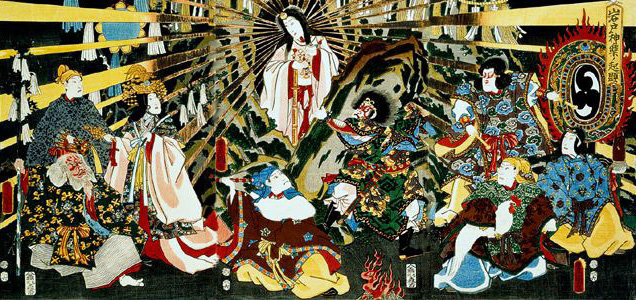 . .The Japanese Sun goddess Amaterasu-ōmikami emerges from a cave to return sunlight to the universe. (Source.) 6 The right-hand margin of Our Story's Chapter 2 shows a patrilenear genealogy of Jesus as found in Matthew 1:1-17. It is composed of three blocks of 14 ancestors marked off by historically exceedingly prominent ones as well as a major event, the exile ordered by Nebuchadnezza of the cream of Israeli society to Babylon. Quoting from Matthew 1:17, "So all the generations from Abraham to David are forteen generations, and from David to the deportation to Babylon forteen generations, and from the deportation to Babylon to the Christ forteen generations." Forteen is twice the perfect number seven, hence 14 is doubly perfect.* Luke did Matthew one better: his list of ancestors from King David to Jesus number 42 instead of 28, thrice forteen generations. Either way, these lineages serve to show that Jesus ought be regarded a lawful inheritor of David's kingship. (Interestingly, Augustine of Hippo noted that the number 76 is associated with the forgiveness of sins; it is the numer of sacrifices offered in the Temple for that purpose.) 7 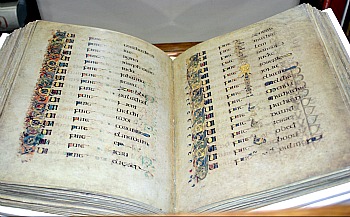 A genealogy of Jesus according to Luke as it appears in the Book of Kells, an illuminated manuscript containing the four gospels of the New Testament. Work on the book was begun in Ireland around 800 AD. (Source.) 8 Family descent was important to the ancient Hebrews; for example, Hebrew males had to prove descent from the Israeli High Priest Aaron, Moses's brother, if they wished to join the Levitical priesthood. 9 Ancient Greeks desirous of elevating their social status used genealogy to prove descent from a god or goddess. Genealogy figured in Greek history from the 5th century B.C. on, but it was unscientific by modern standards. It relied much on material found in epic poetry, notably the Homeric poems Iliad and Odyssee.* 10 Virgil's Aenid, an epic poem, written between 29 and 19 B.C., sings of arms and the hero Aeneas, son of a Greek goddess, who left Troy after it was sacked by the Greek. Eventually he went on to found Rome where he and his Trojan companions became the Romans' forefathers. The Aeneid ecame a national epic that at once tied Rome to the legends of Troy, explained the Punic wars, glorified traditional Roman virtues and legitimized the Julio-Claudian dynasty as descendants of the founders, heroes and gods of Rome and Troy.** Emperor Augustus just loved it and Roman schoolboys readily recited the poem's opening lines, "Arma virumque canto ..." 11 Ancient Roman patriciers (and those who aspired to be) used genealogy to distinguish between patricians (those with proven noble ancestry) and plebians (ordinary folk). 12 In medieval Europe, kinship and descent became of great political importance, especially when the hereditary transmission of fiefdoms of land had to be established. Many privileges of the nobility and gentry depended on birth; a candidate for knighthood needed to furnish proof of ancient nobility. 13 In ancient China, the names of emperors and other rulers were carefully documented. The first was the Qin Dynasty, from 221-206 BC, and the modern name of China comes from that ruler's name, Ch'in. 14 Until the late 19th century, family histories were almost exclusively of interest to persons who had obtained their wealth or rank by inheritance. On the other hand, there were also seeking to suppress their family history because they were shamed of it. 15 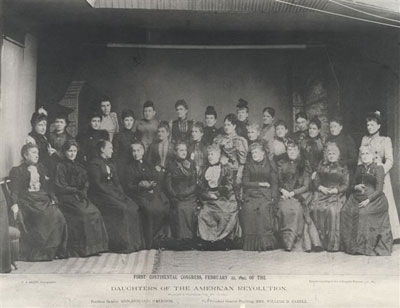 Founders and chapter members of the National Society of the Dames of the American Revolution at their First Continental Congress in 1892. (Source; photo credit: NSDAR.) 16 In the United States or Australia, there was by the 20th-century growing pride in the pioneers and nation-builders, heroes of the American Revolution, Signers of the Declaration of Independence, members of the Boston Tea Party, what have you. Establishing descent from these was a concern in groups such as the National Society of the Daughters of the American Revolution. Eligibility for membership in the DAR required direct descent from a man or woman who actively participated in the American Revolution (1775-1783).* Dozens of other hereditary societies have come into being, following the DAR's lead. 17 A number of Merckelbachs in the Wittem branch belong to The Netherlands' patriciate and as such included in the so-called "Blauwe Boekje" (blue booklet). To be admitted to this august group it must be thoroughly established that a family for at least the most recent 150 years, and without interruption, highly important roles played in Dutch society. Yearly editions of the book are published by the Central Bureau for Genealogy in The Hague as is the "Rode Boekje" (red booklet) listing the genealogy of Dutch nobility.* 18 In Nazi Germany, family histories were compiled to affirm individuals' affiliation with the "master race" and to adhere to legal requirements for marriage. In Germany today, family history is still often perceived as a threat to privacy rather than as a source of self-esteem.* Todays Merckebachs are largely Duch and German and whie it proved rather easy to dig into the Dutch ancestry, it is quite difficult to delve ito the German side of the clan. 19 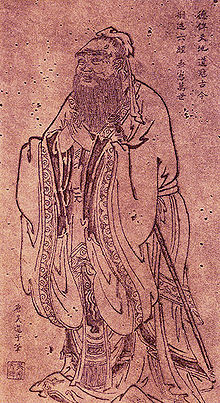 Confucius (551-479 B.C.) was a Chinese teacher, editor, politician, and philosopher. In 1530, he was declared the "Extremely Sage Departed Teacher" (Source.) 20 The longest pedigree in the world today is that of the Confucius's family, the Kongs. It is a father-to-son tree, now in its 83rd generation since Confucius (551 - 479 BC).* Respecting one's ancestors is deeply rooted in Confusion culture. The relationship and obligations of children toward their parents remains intact even after death and it is from this perspective that descendants needed to know their ancestors's identity.*,* 21 The Maori people can recite their pedigree back to when their ancestors first arrived in New Zealand from other Pacific Islands, around 1200 A.D. Coming by canoes, there was not much room for baggage and they needed to rely on memory for their long oral traditions. In communitarian societies such as the Maori's, one's identity is defined as much by one's kin network as by individual achievement, and the question "Who are you?" would be answered by a description of father, mother, and tribe. 22 The Incas, too, kept a genealogical record despite not having a written language. They believed that their emperor was a descendant of the Sun God and the emperor chose his administrators from among his sons and other close relatives. Only pure-blooded Incas held the most important governmental, religious and military offices. 23  The Haida people, a group living on the Queen Charlotte Islands off the coast of British Columbia, Canada, use totem poles to commemorate the lives and deaths of their ancestors. (Source.) 24 Among North American Indians, totem poles were sometimes a genealogical record. For centuries, totem poles were landmarks in the villages of Northwest Coast peoples. These tall poles, carved from wood, traced the histories of families and clans much like a family crest or family tree. Each figure on the pole was a symbol of a family characteristic, an event, or a totem, a power of nature to which the family had a special relation. Totems often took the form of an animal or spirit. 25  The Family History Library, operated by the LDS Church, is the world's largest library dedicated to genealogical research. (Source.) 26 Family history is sad to be practice of some religious belief systems. For example, The Church of Jesus Christ of Latter-day Saints (LDS Church) has a doctrine of baptism for the dead, which necessitates that members of that faith engage in family history research. Mormon doctrine teaches that marriage and families can continue beyond this life. But this can only happen when families are sealed together in one of the Lord's holy temples around the world and united for all eternity. As a consequence, the LDS church maintains a huge collection of genealogical data, some Merckelbachs included. Access is available to all. 27 Because a person's DNA contains information that has been passed down relatively unchanged from early ancestors, DNA analysis is used for genealogical research. Three DNA types are of particular interest: mitochondrial DNA is passed down with only minor mutations through the matrilineal (direct female) line; the Y-chromosome, present only in males, is passed down with only minor mutations through the patrilineal (direct male) line; and the autosomal DNA, which is found in the 22 non-gender specific chromosomes (autosomes) inherited from both parents. Autosomal DNA can uncover relatives from any branch of the family. 28 A genealogical DNA test allows two individuals to find the probability whether they are or not are not related within an estimated number of generations. Individual genetic test results are collected in databases to match people descended from a relatively recent common ancestor. See, for example, the Molecular Genealogy Research Project. These tests are limited to either the patrilineal or the matrilineal line. 29 The list of what causes people to do genealogical research is a long one (Source). Here goes: And thus we see that genealogy is history on a personal scale. It helps satisfy a deep need to understand how we fit into the broader world around us. Genealogy is more than just a collection of single family threads passing through time. It truly is a journey of many lifetimes woven together from the past, the present and (from our perspective) the future.* 32 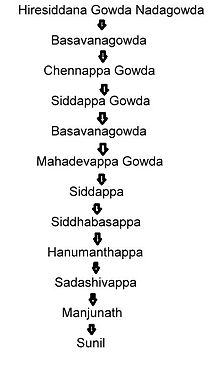 Twelve generations patrilineage in descending order and spanning more than 275 years. Sunil is a Hindu Lingayat male from central Karnataka. (Source.) 33 Form follows function, accordingly different kinds of charts exist to meet a specific needs. Below some of the main types. 34 Descendant charts. - Descendent charts are typically created when a genealogist has been researching their family tree for a little while. They begin with a progenitor (the earliest known ancestor in a particular line), and include all, or most, descendents there after. Descendent charts usually list the name of each ancestor with the years they were born and died. 35 Drop charts. - A variation of descendent charts is called a drop chart, or box chart. These charts are simpler than descendant charts because they list only one child of each ancestor. Therefore drop charts include only your direct ancestors. Like descendent charts, drop charts include the name and years of birth and death for each ancestor. 36 Pedigree charts. - Pedigree charts show a person's direct lineage for a specific number of generations, usually four or five. The next chapter shows a pedigree chart for Eric and Adriana van Eyken, this person's grandchildren. It is very uneven in the sense that in some branches we go back only a few generations whereas other branches reach much further back into the past. 37 Family group sheets. - And then there are family group sheets. Here not only the fathers's and mother's ancestry are shown, but also those of their siblings (brothers and sisters). Hence , famly group sheets become very elaborate. The date and locations for each family members births, deaths, and marriages are typically included on these charts. Other information that may be included is baptism dates and locations, occupations, military involvement, religious affiliation, and burial date and locations. Our own Merckelbach genealogy, by including male as well as female siblings provides thereby contact points for the creation of family group sheets. 38 Bibliography
|
|
The source for much of this chapter is found in Wikipedia. * fn1 Former and current members of the DAR include Clara Barton, founder of the American Red Cross; former Attorney General Janet Reno; actresses Ginger Rogers and Bo Derek; folk artist Anna Mary Robertson Moses, better known as Grandma Moses; the suffragist Susan B. Anthony; as well as a number of the U.S.'s First Ladies: Laura Bush, Barbara Bush, Nancy Reagan, Mamie Eisenhower and Rosalyn Carter. * fn2 "Search for the parents of my soul" is a phrase I owe to Dr James R. Fisher, "the peripatetic philosopher." He reinforced my sense that the way we think owes much to Biblical times. And, of course, well before then—all of which is the topic for Our Story's Chapter 10. * fn3 |
--
| top of page |
|
Text style:
Navigation through this website is explained in Chapter 2, ¶ 20.
"Funny" purple numbers identify paragraphs, graphics, tables, etc. More about them in Chapters 2 and 3.
We endeavor to follow the Chicago Manual of Style for references, citations and footnotes.
* to footnote
![]() return to main text
return to main text
Page maintenance:
Page format: Nov. 22, 2011
Story edit: Nov. 25, 2011
Timeliness
¶ 12 and footnote fn3A (…link changed…):
Reminders
none
Linkcheck: Nov. 25, 2011
XHTML verify: Nov. 25, 2011
Backups: Nov. 25, 2011

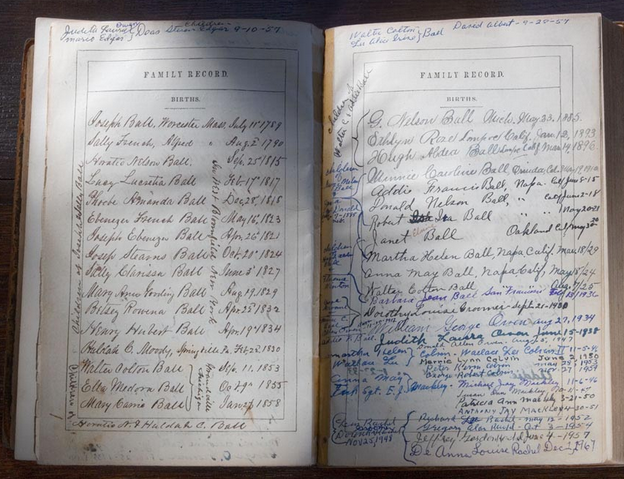
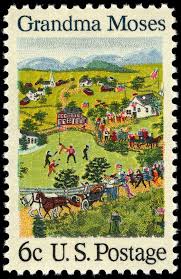 DAR member Grandma Moses was honored bythe U.S. Mail. She began painting at age 78.
DAR member Grandma Moses was honored bythe U.S. Mail. She began painting at age 78.